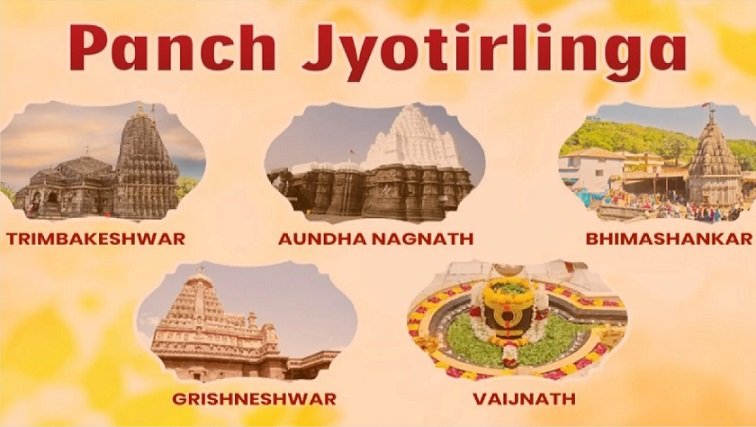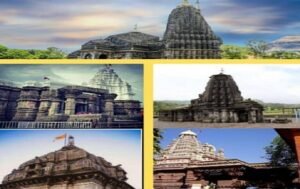Maharashtra Jyotirlinga Tour: Visit the 5 Sacred Temples in Maharashtra

Maharashtra Jyotirlinga Tour
Introduction to Maharashtra’s Jyotirlingas
Maharashtra, a state renowned for its vibrant culture, historical landmarks, and diverse landscapes, is also home to five of the twelve sacred Jyotirlingas of India. These temples hold immense spiritual significance for Hindus, as they are dedicated to Lord Shiva, one of the principal deities in Hinduism. A Maharashtra Jyotirlinga tour offers not only a chance to connect with divine energy but also to explore the rich cultural heritage of this beautiful state.
In this comprehensive guide, we will take you on a spiritual journey through the five sacred Jyotirlingas located in Maharashtra, their historical importance, religious significance, travel tips, and the best times to visit these temples.
The Five Jyotirlingas of Maharashtra
1. Trimbakeshwar Jyotirlinga (Trimbak)
Located near the city of Nashik, Trimbakeshwar is one of the most important Jyotirlingas in Maharashtra. It is believed that this temple is the source of the Godavari River, one of the most sacred rivers in India. The Trimbakeshwar temple is dedicated to Lord Shiva, and it is unique because the Shivling here has three faces representing Brahma, Vishnu, and Shiva.
Key Facts:
- Location: Trimbak, Nashik
- Significance: The source of the Godavari River, representing three deities.
- Temple Architecture: Intricate carvings and a serene environment.
Best Time to Visit:
The ideal time to visit is between October and March when the weather is pleasant.
2. Kedarnath Jyotirlinga (Kedarnath)
Kedarnath is one of the most famous pilgrimage destinations in India, located in the rugged terrains of the Western Ghats. The Kedarnath temple is one of the 12 Jyotirlingas and is known for its breathtaking location amidst snow-covered peaks. The temple is dedicated to Lord Shiva and holds a significant place in Hindu mythology, as it is believed that the Pandavas sought Lord Shiva’s blessing here.
Key Facts:
- Location: Kedarnath, Western Maharashtra
- Significance: Connected with the Pandavas’ quest for divine blessings.
- Temple Architecture: Ancient stone temple with beautiful surroundings.
Best Time to Visit:
The best time to visit Kedarnath is during the summer months (May to October) due to the harsh winter conditions.
3. Aundha Jyotirlinga (Aundha)
Located in the Jalna district of Maharashtra, Aundha is another Jyotirlinga temple that holds great importance for devotees. Lord Shiva, in his Jyotirlinga form, fulfills the wishes of his devotees at this temple. Surrounded by natural beauty, this temple is an ideal location for those seeking peace and spirituality.
Key Facts:
- Location: Aundha, Jalna district
- Significance: Believed to fulfill the desires of devotees.
- Temple Architecture: Simple yet serene, surrounded by scenic beauty.
Best Time to Visit:
November to February is the best time to visit Aundha due to the mild weather conditions.
4. Bhimashankar Jyotirlinga (Bhimashankar)
Nestled in the Sahyadri hills, Bhimashankar is another important Jyotirlinga in Maharashtra, located near Pune. This temple is dedicated to Lord Shiva and is associated with the legendary battle between Lord Shiva and the demon Tripurasura. The temple’s location amidst lush green forests makes it a peaceful retreat for pilgrims and nature lovers alike.
Key Facts:
- Location: Bhimashankar, Pune
- Significance: Linked with the mythological battle between Lord Shiva and Tripurasura.
- Temple Architecture: The temple showcases a mix of traditional and modern architecture.
Best Time to Visit:
The monsoon season (June to September) is ideal for nature lovers, while the winter months (October to February) offer a more comfortable pilgrimage experience.
5. Grishneshwar Jyotirlinga (Ellora)
Grishneshwar is located near the Ellora caves in Aurangabad, Maharashtra. Devotees believe that worshiping at this temple relieves them of sins and helps achieve liberation (moksha). The Grishneshwar temple has a distinct architectural style with intricate carvings, making it a visual delight for visitors.
Key Facts:
- Location: Ellora, Aurangabad
- Significance: Helps devotees attain moksha.
- Temple Architecture: Intricate carvings and architectural beauty.

Maharashtra Jyotirlinga Tour
Best Time to Visit:
The best time to visit Grishneshwar is between October and March due to the pleasant weather.
Table: Key Details of Maharashtra’s Jyotirlingas
| Jyotirlinga | Location | Historical Significance | Best Time to Visit | Notable Features |
|---|---|---|---|---|
| Trimbakeshwar | Trimbak, Nashik | Source of the Godavari River, three faces of Lord Shiva | October to March | Represents Brahma, Vishnu, and Shiva |
| Kedarnath | Kedarnath, Western Ghats | Pandavas sought Lord Shiva’s blessings | May to October | Surrounded by snow-capped peaks |
| Aundha | Aundha, Jalna | Fulfills the desires of devotees | November to February | Simple and serene temple environment |
| Bhimashankar | Bhimashankar, Pune | Associated with the battle between Shiva and Tripurasura | June to September (monsoon) | Peaceful, lush green environment |
| Grishneshwar | Ellora, Aurangabad | Relieves sins and grants moksha to devotees | October to March | Beautiful carvings and architecture |
How to Plan Your Maharashtra Jyotirlinga Tour
Embarking on a Maharashtra Jyotirlinga tour is a journey that demands careful planning. Here are a few tips to help you make the most of your trip:
1. Transportation
Maharashtra is well-connected by rail, road, and air, making travel to the Jyotirlingas relatively easy. You can take flights to Mumbai or Pune, which are major hubs, and then travel by road or train to your chosen destinations.
- By Air: Major airports are located in Mumbai, Pune, and Nashik.
- By Train: Maharashtra has a vast railway network, and major stations like Mumbai CST, Pune Junction, and Nashik Junction are easily accessible.
- By Road: Renting a car or taking buses are popular options for road trips in Maharashtra.
2. Accommodation
Maharashtra has a wide range of accommodation options, from budget hotels to luxury resorts. Many of the temples have guest houses or nearby hotels offering affordable lodging options for pilgrims.
3. Guides and Temples’ Timings
It is recommended to hire local guides at each Jyotirlinga temple to better understand the religious significance and history. Temples typically open early in the morning around 5 AM and close by 9 PM, though timings may vary, so it’s best to check in advance.
4. Dress Code and Etiquette
- Wear modest, respectful clothing while visiting temples.
- Remove your shoes before entering the temple premises.
- Make sure to carry an offering, as many temples have specific rituals that you can participate in.
Conclusion: The Spiritual Journey Awaits
A Maharashtra Jyotirlinga tour is not just a religious pilgrimage but an exploration of the state’s rich culture, serene landscapes, and divine energy. Whether you are a devotee of Lord Shiva or simply looking for a soul-stirring experience, visiting these five sacred temples will leave you with memories that last a lifetime.





